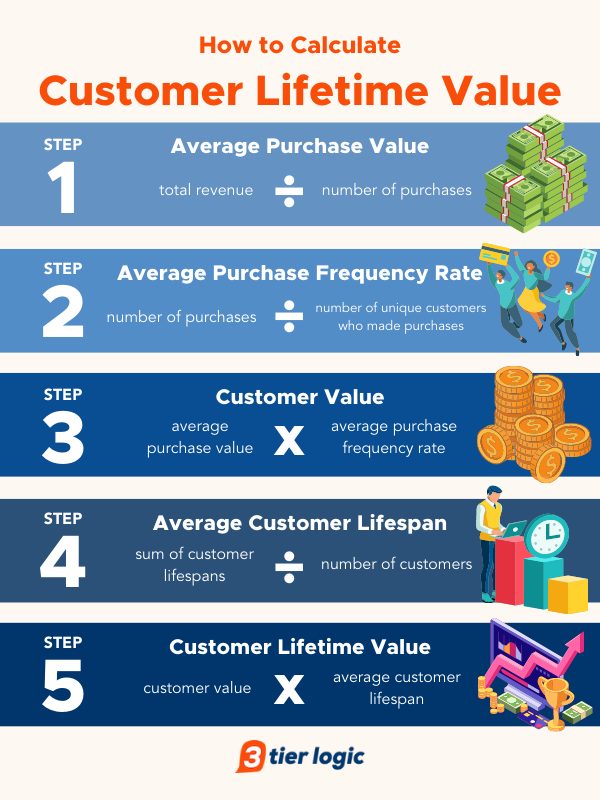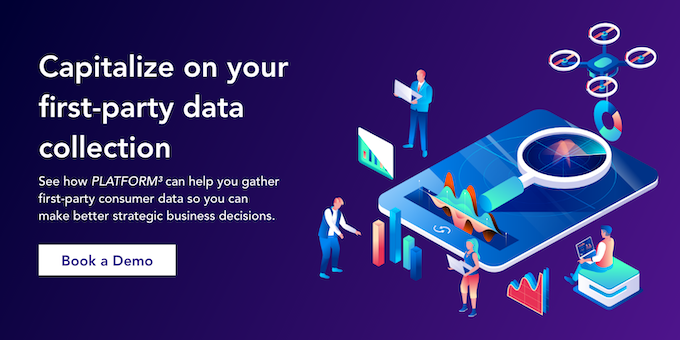Why Is Customer Lifetime Value So Important?
When determining financial gains, losses, and other metrics of importance, businesses tend to focus on the obvious: the cost of resources and labor, the growth of revenue and profit, and so on. If they collect the right information and first-party data, they can make informed business decisions that lead to long-term financial success. However, companies should also be fully aware of what value their customers bring to the business. Customer lifetime value is an important measure that they should invest time and resources into understanding so they can gauge their financial viability. What is customer lifetime value, and how should companies leverage it to drive increased sales, brand loyalty, and customer retention?
What is customer lifetime value?
Customer lifetime value (CLV) is the total amount of money a customer is expected to spend on your products and services in their lifetime. You can also look at it as the monetary value they bring to your business. For example, if you own a bookstore, how much do you expect your customers to spend over the course of their relationship with your store, and how does this differ between people who buy comic books and people who buy mystery novels? If you run a car repair shop, what is the estimated amount of money your customers will pay for you to maintain and fix their vehicles, and how does this differ between someone who drives a minivan and someone who drives a sports car? Companies need to attribute their customers to a dollar amount based on their estimated spend to get a better sense of what they’re worth.
Why is customer lifetime value so important?
Customer lifetime value is important to your business because it helps answer some key questions that determine future strategic decisions:
How much do you need to invest to acquire, engage, and retain your customers?
Is the cost of maintaining your relationship with your customers more than their CLV?
Which of your products and services have the highest profitability?
What is the financial impact of your business strategies and marketing efforts?
Benefits of understanding customer lifetime value
Understanding your CLV gives you a better sense of your business’s overall profitability. It also helps you identify ways to increase your return on investment and decrease your customer acquisition costs (CAC). New customers require notably higher costs and result in lower profit margins, while repeat customers cost significantly less to engage and retain. Studies have also shown that a 5% increase in customer retention can lead to as much as a 95% rise in profits. When companies know and understand their CLV, they can improve their customer retention and in turn, improve their sales and revenue.
Significant increases in ROI means a steady cash flow and bigger profit margins. When companies invest time and resources into nurturing their CLV by anticipating and fulfilling their customers’ needs, their increased profits are reinvested back into the business. Understanding customer lifetime value can lead to additional resources for product research, business development, team expansion, and so on.
CLV also helps determine which products and services are most profitable and result in the highest customer retention. Products that are purchased frequently and/or in large quantities are likely to be of the best quality, and are what keeps customers coming back. CLV also helps identify potential areas of improvement. For example, if you have a low overall customer lifetime value, that may be an indication of poor product quality or bad customer service.
Lastly, customer lifetime value gives you a clearer understanding of the impact of your business decisions and marketing strategies. For example, was your new product more successful with bringing in new customers or bringing back existing customers? Did your latest ad campaign cost less than the value of the potential customers you acquired? CLV and other metrics like conversion rates and CAC gives marketers an idea of what worked, who it worked on, and what needs adjusting before moving forward.
How to calculate customer lifetime value
There are two CLV models: historic and predictive. Historic CLV looks at past data by using average purchase value, which doesn’t necessarily take individual customer journeys into account. Predictive CLV focuses on forecasting the value of both new and existing customers, and helps to understand profitability and improve customer retention.
To calculate customer lifetime value, you need to determine the following:
Average purchase value: total revenue divided by the number of purchases
Average purchase frequency rate: number of purchases divided by the number of unique customers who made purchases
Customer value: average purchase value multiplied by average purchase frequency rate
Average customer lifespan: sum of customer lifespans divided by number of customers
From there, customer lifetime value is simply customer value multiplied by average customer lifespan. This gives you an approximation of how much revenue your average customer is expected to generate over the course of their relationship with your company.
How to apply customer lifetime value
Segmentation and forecasting
The main purpose of customer lifetime value is to predict how much money customers will spend on your business. Essentially, this means CLV assists in forecasting a company’s future sales and revenue. Brands can also use CLV to segment and target customers based on their predicted value, such as separating those who have spent hundreds from those who have spent thousands. When companies have a strong understanding of how much value their customers bring to the business, they can better target them with the right messaging and incentives.
Customer retention and relationship management
Customer lifetime value helps businesses understand how to better retain customers and nurture their relationships with them. It gives them an idea of where shoppers are on their path to purchase and how to encourage them to move onto the next stage of their customer journey and make them feel valued. For example, if you have new customers who have only made one purchase, give them reasons to make another. If you have loyal customers who have invested thousands of dollars into your company, offer incentives for becoming a brand advocate so they can amplify your reach and exposure.
Business objectives and strategy optimization
CLV is used to make decisions, adjust objectives, and measure progress in a number of different ways. It acts as a good indicator of how well you’re meeting your financial targets, customer retention goals, and marketing KPIs. It can also help brands and marketers get a clear idea of how each of their business and marketing efforts are helping or harming their customer acquisition costs and return on investment. As mentioned previously, a low overall CLV indicates the need for improvement. On the other hand, if companies have a significant number of customers with a high CLV, it’s a good sign that their strategies are working well.
How to improve your customer lifetime value
Optimize your onboarding process
Companies need to be conscious of their customers’ first impressions of them. 70% report that understanding a company’s products and services is important to securing their business. Whether done through welcome emails, website registrations, or walkthrough tutorials, the onboarding process should be quick, informative, and easy to follow. If customers have a clear understanding of what you offer and what value that offer holds, they’re more likely to make additional purchases and form a long-term relationship with your company.
Nurture purchase value and purchase frequency
Brands should provide value and incentives for customers to spend more and buy more often. For example, offering discounts and free products encourages consumers to make another purchase. Special promotions like sweepstakes, contests, and loyalty programs incentivize them to shop more frequently by offering the chance to win prizes and rewards. Up-selling and cross-selling additional or related products also encourages shoppers to increase their purchase value on the spot. 70 to 95% of revenue is generated from up-selling alone, while just 5 to 30% comes from the initial purchase.
Prioritize customer support and communication
Shoppers want their brand experiences to be consistent, frictionless, and connected across all marketing channels. Retaining customers and improving your CLV means offering quality service and consistent communication. Customers should have a clear idea of how to contact customer support or how to make a return. It should also be easy for them to find information about new products or upcoming sales. 68% of customers are willing to pay more for brands that offer quality customer service. If they don’t know how to reach you or you aren’t making an effort to connect with them, they’re less likely to stick around. As much as one-third of customers will switch brands after just one occurence of bad customer service.
Personalize your products and services
Customers are most invested in brands that fulfill their individual wants and needs. When they feel heard, understood, and appreciated, they form a strong emotional connection with your brand and invest more in your products as a result. In fact, 80% of repeat customers only shop with brands that offer personalized experiences. Companies can improve their CLV and nurture customer retention and loyalty by incorporating personalization into their offerings. This might mean personalized recommendations, targeted emails and messages, or exclusive deals and discounts.
Leverage first-party data
If companies want to improve their CLV by optimizing their onboarding process, prioritizing their customer service, and personalizing their offerings, they need to capture, analyze, and utilize first-party data. For example, do your welcome emails have a high clickthrough rate or high unsubscribe rate? Are people leaving positive ratings or negative reviews after talking to customer support? Do your customers spend more when they’re given personalized recommendations or targeted messages? Data helps identify which areas of your business are affecting your customer acquisition costs, return on investment, and customer lifetime value.
Why first-party data is important for CLV
Customer lifetime value is important for understanding your company’s profitability and the impact of your business decisions on customer retention and loyalty, brand awareness and engagement, and financial viability and growth. In order to measure CLV and leverage its benefits, companies need to collect first-party data. It gives them valuable insights into their consumers’ preferences and purchasing behavior, which helps marketers learn how to better engage and retain their customers.
3 tier logic’s PLATFORM³ helps brands create marketing campaigns like gift with purchase promotions, giveaways, and loyalty programs to engage with consumers, improve their customer retention, and capture first-party data. The Data Capture & Analytics module gives marketers the information they need to guide future business decisions and connect with their customers. To learn more, book a demo with our team today.




